#from Ancient History Hub
Text

3 notes
·
View notes
Text
In the weeks since Hamas' Oct. 7 attack, Israeli airstrikes on the Gaza Strip have killed more than 15,000 Palestinians, according to Gaza's health ministry, and destroyed thousands of homes in the territory.
And there have also been tremendous losses to the region's ancient and globally significant cultural heritage. The region was a hub for commerce and culture under Egyptian, Greek, Roman and Byzantine rule. It remained influential for centuries thereafter.
A recent survey by the group Heritage for Peace details the damage done so far to more than 100 of these landmarks in Gaza since the start of the present conflict.
The casualties include the Great Omari Mosque, one of the most important and ancient mosques in historical Palestine; the Church of Saint Porphyrius, thought to be the third oldest church in the entire world; a 2,000-year-old Roman cemetery in northern Gaza excavated only last year; and the Rafah Museum, a space in southern Gaza which was dedicated to teaching about the territory's long and multi-layered heritage — until it was hammered by airstrikes early on in the conflict. (...)
"If this heritage be no more in Gaza, it will be a big loss of the identity of the people in Gaza," said Isber Sabrine, president of Heritage for Peace, in an interview with NPR. (...)
"The people in Gaza, they have the right to keep and to save this heritage, to tell the history, the importance of this land," he said.
The 1954 Hague Convention, agreed to by Palestinians and Israelis, is supposed to safeguard landmarks from the ravages of war. But landmarks in Gaza have been destroyed by Israeli strikes in earlier rounds of fighting. Dozens of sites, including the now-obliterated Great Omari Mosque, suffered damage in 2014. A report by UNESCO, the United Nations body that designates and protects World Heritage sites, cites further destruction to cultural and historic sites in Gaza in 2021. (...)
Destruction of historical sites and other cultural sites is part of genocide, it's the destruction of the proof of a people's relationship to the land and a horrible emotional blow at the community. UNESCO must act immediately against Israel's destruction of Palestinian heritage, and every country and international organism must expel Israel and impose sanctions to make the genocide and apartheid end.
#💬#palestine#gaza#israel#free palestine#world heritage#cultural heritage#historical sites#archaeology#cultures
2K notes
·
View notes
Text
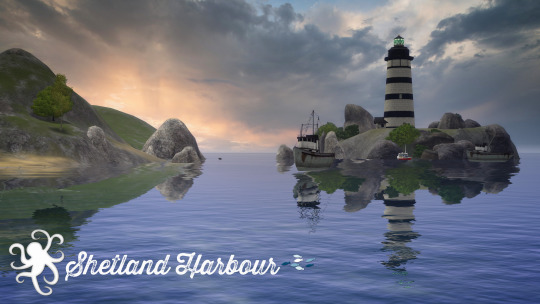
A BRAND NEW SIMS 3 WORLD : SHETLAND HARBOUR
And here we are ... At last :D
10 years ago, Rope crafted a remarkable world, inspired by Starlight Shores, and generously given away to the community : Brightwater.
We embraced this gift, transforming and reshaping it, creating an island to eliminate distant terrain, and thus, Shetland Harbour was born ...
While many creators have fashioned stunning Sims 3 worlds with a Northern charm—like Saaqartoq, Greymont Bay, Lillebror, or Plymouth Isles—ours, stands a little apart.
Shetland Harbour is a unique blend : a touch of Aurora Skies, a hint of Moonlight Falls, and a dash of the unfortunate Barnacle Bay, all interwoven with our own vision of course. It is a vast yet easily navigable world, balanced between lightness and richness, featuring nearly all the Rabbit Holes the game offers.
Our aim was to craft a cohesive and vibrant world, one that feels alive and contemporary, with harmonious architecture and a spirit that invites exploration and delight :)

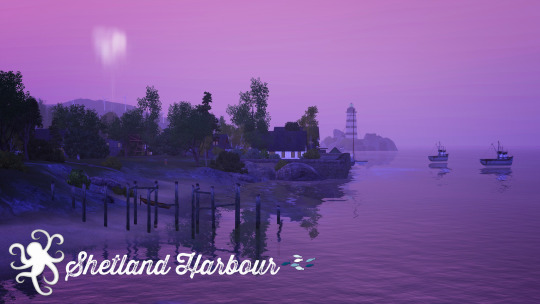
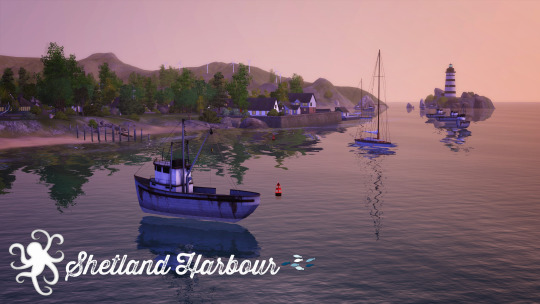
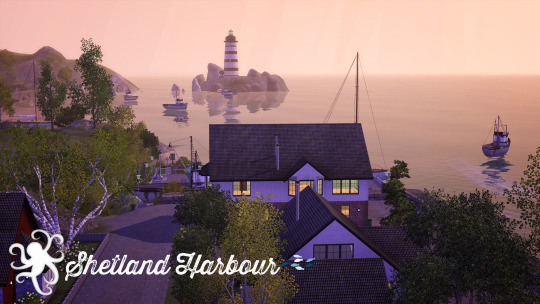
Welcome to Shetland Harbour, a picturesque coastal town nestled between rolling green hills and a fantastic bay … It is a beautiful medium/large-sized world, a community nestled on its own secluded island, accessible only by ferry. The town is known for its charming cobblestone streets, a vibrant fish market, and a rich history dating back centuries, dotted with quaint cottages, a bustling coast, and a grand lighthouse standing guard at the harbor’s entrance ...
This hidden gem is a haven for sheep, but don't let that fool you – Shetland Harbour is far from a sleepy place. With its rich maritime history, the town offers a unique blend of tradition and vibrant local culture.
Designed to capture the essence of a northern European island, Shetland Harbour offers a self-contained community with 100 lots in total : 65 residential lots + 35 community lots. Each Lot ( except the Old Renovated Factory ) is fully furnished.
In addition, there are multiple sheep ( all by Murfeel ) fields here and there – the latter being especially dear to the local culture, a close-knit community, where the ocean's presence is always felt and the simplicity of rural life is celebrated.
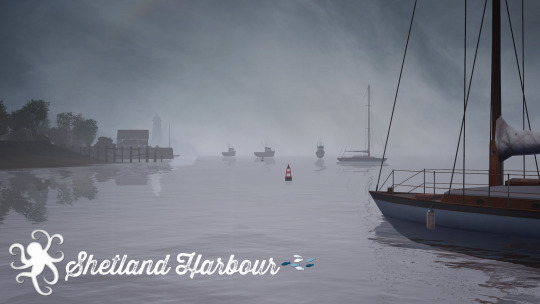

Shetland Harbour combines a lively downtown with peaceful suburbs and serene neighborhoods, featuring quaint cottages, charming gardens, and scenic paths through lush greenery.
The town's historic churches, like Old Church, Albert Church or Lux Chapel, are steeped in tales of ancient rituals and ghostly apparitions ... Albert Church, built on a Druidic site, is haunted by druid spirits, while Lux Chapel is known for the ghost of a sailor, seen on stormy nights ...
The mysterious stone circle inside the Graveyard, Ghost Place, adds to the island's mystical allure. Rumored to be a portal to another realm, it activates during celestial alignments, with visitors reporting strange occurrences. Town elders speak of a prophecy foretelling the return of ancient spirits and the awakening of the island's mystical powers. Signs include a rare star alignment, the stone circle's awakening, and three chosen individuals with the island's ancient bloodline ...
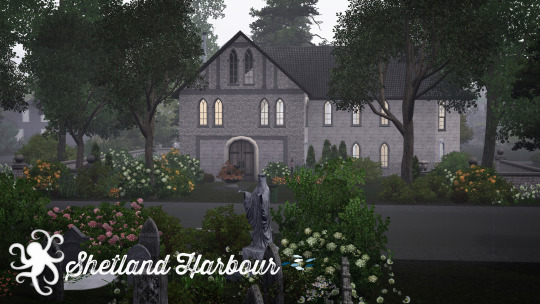




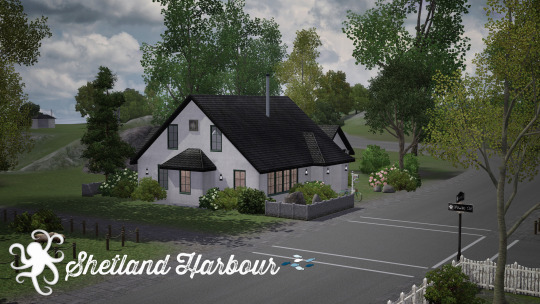


• Harbor Bay : The central feature of Shetland Harbour is its expansive bay. The bay is a natural harbor with calm, crystal-clear waters, making it ideal for fishing and sailing. It is surrounded by gently sloping hills and cliffs that provide stunning vistas of the sea. The marina is bustling with fishing boats, sailboats, and yachts sometimes … It’s the hub of maritime activity, with a fish market ( aka Grocery Store ), boat repairs, and a sailing club ( aka Business and Journalism Center )
• Lighthouse District : Right beside the Harbour, stands the Lighthouse Point, this district features historical homes and buildings, including a Norman cottage, a strange Diner and higher into the Hills, a fantastic museum dedicated to the town’s maritime history and a recent Hospital ready to welcome all the citizens of Shetland Harbour :)
• Beaches : The Coastline is dotted with sandy beaches, perfect for beachcombing, picnics, and bonfires. These areas are popular spots for locals and tourists alike. And you may want building some Coastal Houses for your Sims which is possible almost all alongside the sea ;)
• Old Town : The heart of Shetland Harbour is the Old Town, characterized by cobblestone streets, historic buildings, and a charming town square. Shetland Harbour's downtown area is a kinda picturesque pedestrian square, and quaint paths perfect for leisurely strolls …The Old Town includes the Town Hall, the Old Toad, the Talking Dog, a Fish and Chips, and even a Geek Store, all of them under the shadow of one of the oldest shop of the Island : the Elixirium ...
• Rolling Hills : Surrounding the town are rolling green hills covered in wildflowers and dotted with grazing sheep. These hills are perfect for hiking and offer panoramic views of the town and the bay. Beware of the fog !
• Forests and Woodlands : To the north of the town are more dense forests and woodlands with waterfalls upstream of the river which separates part of the island. These areas are home to various wildlife and provide a natural retreat for the residents. There are several well-maintained trails for hiking and exploring :)
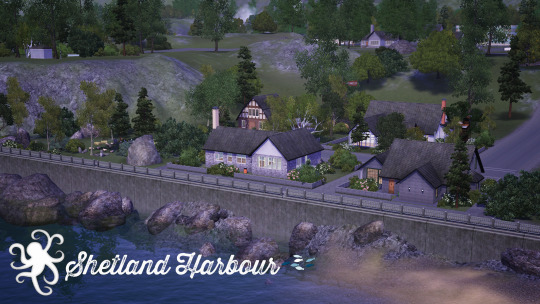

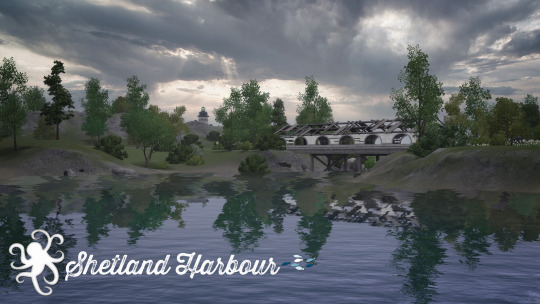

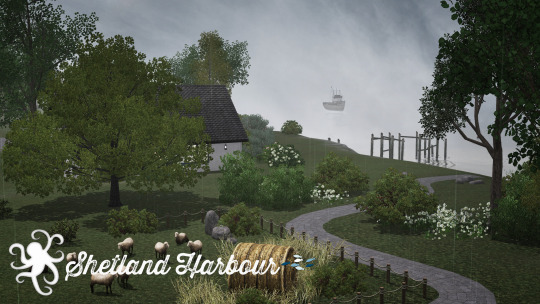


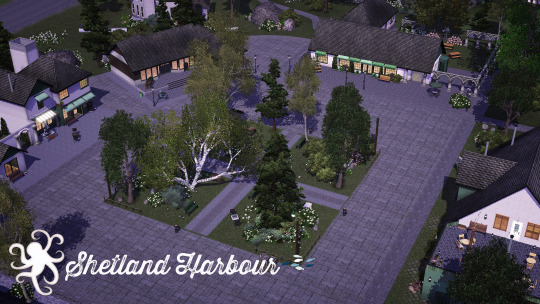
Come and explore Shetland Harbour all your content ... Whether you're building your dream home, running a local business, or simply soaking in the serene atmosphere, this unique town promises endless possibilities and a truly captivating experience ...
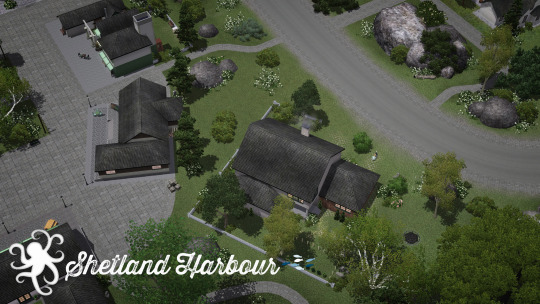
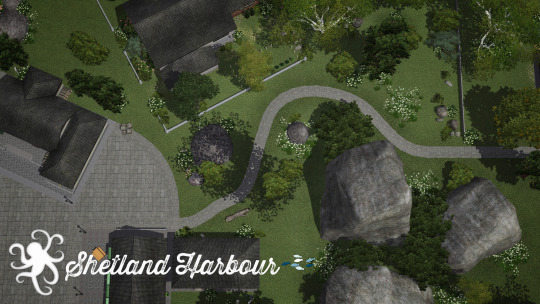
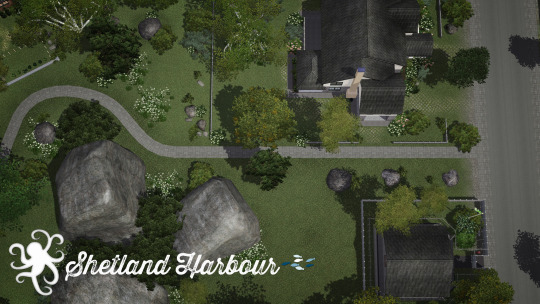

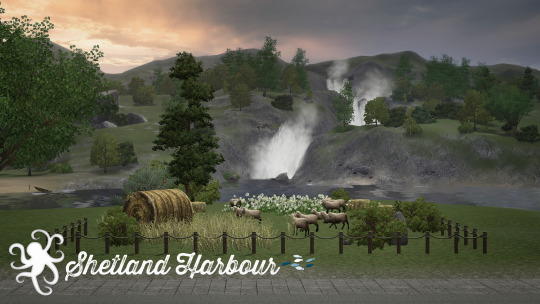

Download Shetland Harbour today and start your new adventure!
\o/
- - - - - - - - - - - - - - - - - - - - - - -
IMPORTANT : Before downloading Shetland Harbour !!!
Shetland Harbour contains custom content. As much as we try to include them into the world building process, we learned with time the necessity of providing a list those items. No worries, we used the same cc creators as usual and added 2 or 3 more. Such as the grey/dark roof we made, based on the terracotta roof of the game and the Wood walls you'll find on different lots, the same as the ones of Oaksoak Hollow ... Or more important, the boats used in the world and of course ... The sheeps ! All you need should be included and/or available down here ;)
1) the ANTS & CC :)
ANTS stand for Absolute Necessary Things & Stuff to enjoy Shetland Harbour :)
Download ANTS and CC ( both are needed to have all the right textures, the right look and feel of Shetland Harbour )
You will need too some of our Rabbit Holes
Not mandatory but nice : our 88 Patterns mostly brick, masonry, concrete and wood ;) A bit of fabric & paper too ...
ATTENTION : if you have played with one of our Worlds, you might see duplicate files. We try to use the same objects as much as possible. Of course, you don't have to install twice. Skip whatever you already have. We use Blams objects for some Sims 3 objects ... so if you already have those objects from any other means, just skip ;)
CREDITS & THANKS due to all the following creators :
ATS, Noir and Dark Sims, pitheinfinite, Brunnis-2, Blams, CycloneSue, HydrangeaChainsaw, Leroy157, Lisen801, Murfeele, Nilxis, PotatoBalladSims, Qahne, TheJim07, Mammut ( from BlackSimsZoo ) BlueCoco, BuffSumm, JomSims, Ladesire, Mutske
2) the Saved Games
They are in the same page than Shetland Harbour itself. You have the choice between Unpopulated and Half-populated. Whatever you choose, we always strongly advice with a save game ;) But as far we know, once we delivered a World, it is entirely up to you to begin a new adventure and make your own challenges with your own Sims :D
Download a save game
3) the Lots ( both residential & community )
Quite a bursting town, Shetland Harbour has 100 lots : 65 residential and 35 community and very important : many small sheep fields ( visitors not allowed com lots )
Download ALL the lots
Some lots are Maxis ones we modified, some lots are our own creations, and for the others, they come mostly from MTS ;) And we are very grateful to those creators who always offer a special flavor to our Worlds :)
CarlDillynson - Bellakenobi - Bast - MySimRealty - stonee206 - Norn - Cutbacks - Ferguson Avenue - SimplySimlish - hazelnutter100 - PolarBearSims - RubyRed2021 - CircusWolf - Moihi - Lasciel
Well, it is time for discovery now and you are ready for sure ! We wish you all the best, all the fun with your new life in Shetland Harbour !
Download Shetland Harbour World
PS : Shetland Harbour is a medium/large sized world of 88MB, and has been tested 1 week long on both Mac and Pc ;)
xoxo - blackgryffin
#the sims 3#sims 3 gameplay#sims 3#thesims3#ts3#sims3 worlds#sims3 build#shetland harbour#sims 3 world#sims3 cc#k hippie#k-hippie
700 notes
·
View notes
Text
Hey folks, just dropping some resources here for those of you who, like me, are always on the hunt for free reading material, whether it's for research or just to satisfy your curiosity. Check these out:
Library of Congress: Absolute goldmine for academic researches and historical documents. You can spend hours diving into their collections.
Z-library: A treasure trove of books, articles, and papers on pretty much any topic you can think of. Quick downloads, no fuss.
Project Gutenberg: Free e-books galore, especially if you're into classics. Saved me from many a boring commute.
Internet Archive: A digital library offering free universal access to books, movies, and music, plus archived web pages. Endless hours of browsing joy.
Google Books: Sometimes you just need a quick peek inside a book without committing to buying it. Google Books has got your back.
Google Scholar: It scours through scholarly sources, journals, theses, and more. Just be ready to sift through some dense material.
JSTOR: Another heavyweight in the academic world. JSTOR is packed with scholarly articles, books, and primary sources across various disciplines. Some stuff may be behind a paywall, but there's still plenty to explore for free.
Newspaper Archive: Want to browse through historical newspapers? This site has a massive collection spanning centuries and covering a wide range of topics. Perfect for digging up primary sources.
Newspapers.com: Need more historical newspapers? Look no further.
Perseus Digital Library: Focuses on ancient Greco-Roman materials, perfect for those deep dives into classical history.
Digital Public Library of America: Another treasure trove of digitized materials, including photos, manuscripts, and more.
Europeana: European cultural heritage online. Images, texts, the whole shebang.
DOAJ: Open access journals. DOAJ indexes and provides access to high-quality, peer-reviewed open access research journals.
Open Library: Another digital library offering over 1.7 million free eBooks.
Librivox: Audiobooks for when your eyes need a break.
National Archives (UK): Offers access to a wealth of historical documents, including government records, maps, photographs, and more.
Sci-Hub: For the rebels. Access to scholarly articles.
Directory of Open Access Books (DOAB): Looking for free scholarly books? DOAB has got you covered with a vast collection.
Digital Commons Network: Free, full-text scholarly articles from hundreds of universities and colleges worldwide.
Directory of Open Access Repositories (OpenDOAR): Find open access repositories worldwide.
Gallica (Bibliothèque nationale de France): French flair for your research.
DigitalNZ: Your gateway to New Zealand's digital heritage.
#college life#study#resources#history nerd#anthropology#online learning#academic life#ResearchResources#DigitalArchives#free books#free#digital#archives#libraries#academic#research#books
213 notes
·
View notes
Text
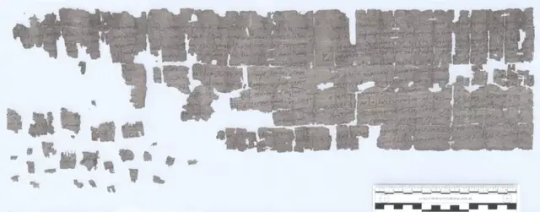
Archaeologists Find Roman Centurions' Letters in Ancient Animal Cemetery in Egypt
Discovered among the graves of hundreds of cats, dogs and monkeys, the correspondence was likely written by centurions in the first century.
An ancient pet cemetery in Egypt is becoming a gold mine for rare Roman history. Alongside its carefully constructed graves of more than 200 beloved cats, dogs and monkeys, archaeologists have now found letters handwritten 1,900 years ago by Roman centurions stationed nearby.
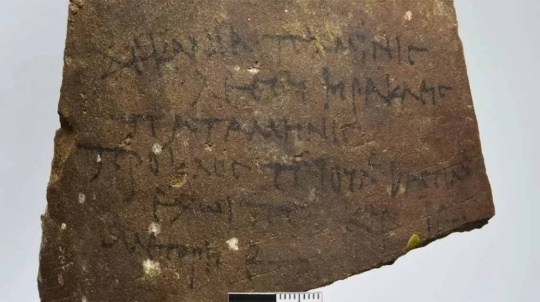
Though Rome controlled Egypt for centuries—from the year 30 to the mid-600s—few Roman sites still exist in the region, lead researcher Marta Osypińska, an archaeologist at Poland’s University of Wrocław’s Institute of Archaeology, tells Science in Poland’s Ewelina Krajczyńska. The burial ground, which dates back to the first and second centuries, is located in Berenike, a Red Sea port in southern Egypt built by Roman Emperor Tiberius.
Osypińska’s team first discovered the cemetery in 2011, and they’ve been slowly excavating it since then. Among the burials of cats, dogs and exotic monkeys, researchers have found ceramics, Roman coins and now, several letters written on papyrus by military officers who commanded units of Roman legions.
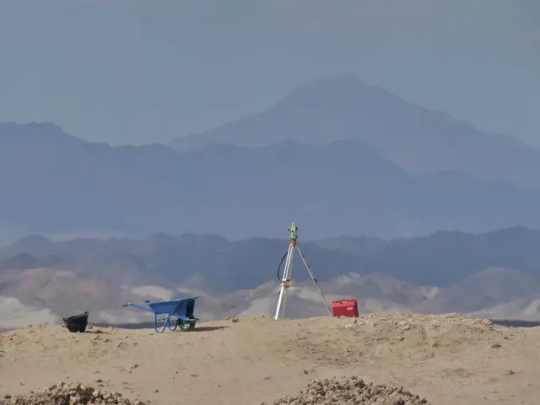
According to a statement by the University of Wrocław, these “priceless sources of knowledge about the ancient inhabitants of Berenike” are from the era of Emperor Nero, a cruel Roman ruler of the mid-first century. During his reign, Berenike was a hub of cross-continental trade, through which goods from India, Arabia and East Africa flowed, Osypińska says in the statement. The port was home to regional merchants, Roman higher-ups in charge of trading and—as historians have long suspected but never before proven—a unit of the Roman military.
The newly-found correspondence contains several names of presumed Roman centurions: Haosus, Lucinius and Petronius. In one letter, Petronius asks Lucinius, who is stationed in Berenike, about the prices of some exclusive goods, Osypińska tells Science in Poland. Petronius writes that he’s sending money via “dromedarius,” a unit of Roman soldiers traveling on camels, and tells Lucinius to provide the soldiers with veal and tentpoles.
Researchers believe ancient Romans likely kept the papyri in a nearby office which was later destroyed, accidentally distributing its contents over the pet cemetery, as McClatchy’s Aspen Pflughoeft writes. Excavators found the papyrus in rolled fragments, which they showed to Rodney Asta, an expert of ancient inscriptions, who pieced together a page approximately one and a half feet long and a foot wide, Osypińska tells Science in Poland. Among the animal graves, researchers have found countless ostracons—pieces of pottery etched with writing—but the papyri are the first paper texts to be found on-site.
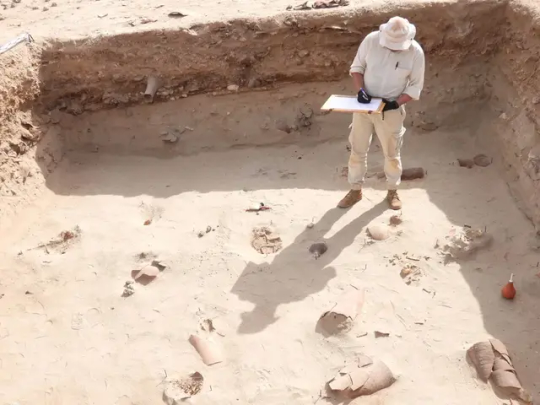

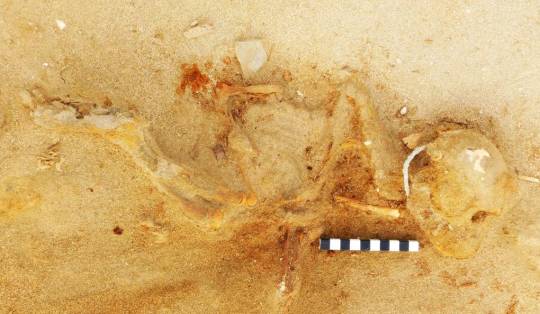
The letters are the latest evidence of advanced Roman trade to be found in the cemetery, per the statement: The skeletons of several buried monkeys, recently identified as macaques native to India, show that Romans imported non-utilitarian animals across oceans. These primates, along with long-haired cats and miniature dogs, were “elite pets,” and many were buried with toys, ceramics or other animal companions.
As Osypińska notes in the statement, it may seem difficult to reconcile the image of commanders of an ancient foreign legion with such animals, which were “treated as family members.”
“However, our findings unequivocally show that the military elite surrounded themselves with elite pets and led an exclusive lifestyle,” she adds.
By Sonja Anderson.

#Archaeologists Find Roman Centurions' Letters in Ancient Animal Cemetery in Egypt#Berenike#ancient pet cemetery in Egypt#Roman Emperor Tiberius#ancient artifacts#archeology#archeolgst#history#history news#ancient history#ancient culture#ancient civilizations#roman history#roman empire
74 notes
·
View notes
Text
"Okay," Zelda said, smacking her fist into her palm. "This one is going to be it."
Silently, her companion added a scratch mark to some parchment he'd been carrying.
Zelda glanced at him, eyes narrowing. "Are you keeping tabs?"
"Only when you say this one is going to be it or some variation of it," Link replied smoothly.
Zelda huffed, ready to argue, when out of curiosity she asked, "Where are we at?"
"Eight."
"Ha! I expected more! This is good, then."
Link sighed. "What's the story with this one?"
"Hear me out," Zelda started excitedly, spreading her hands like she was opening a large book. "A thousand years ago our land was encased in shadow."
Link stopped his horse, staring at her. "Is this another one of Beedle's stories? The last one nearly got us killed."
"No, no, no!" Zelda grumbled, rolling her eyes. "This one is from my family. History may have turned to hearsay and legend for the common folk of Hyrule, but it's sacred to my family. This one actually happened!"
Link raised an eyebrow, skeptical, but urged his steed to start moving nonetheless.
"So," Zelda continued. "A thousand years ago, shadows came to our land and cursed our people. My ancestor joined up with royalty from a distant land and together, they summoned the Hero of Light, who destroyed the shadows. That very Hero lived in the village we're going to!"
Link had to admit... he was still dubious, but he was a little curious. "An actual Hero? There's relics of one of the acutal Heroes? What royalty from a distant land? The only neighboring land I know of fell to ruin a hundred years ago."
"I don't know where it was, honestly," Zelda answered sincerely. "They were always really vague about it and I don't know why. But apparently the person died, so they honored her sacrifice."
Link hummed, tossing his braid back over his shoulder. After going through multiple villages, towns, and even a city, the fact that they were going somewhere that might have housed an actual Hero at some point in history was almost promising. Perhaps Zelda would find who she was looking for and Link could return to his quiet home and avoid all this mess.
It seemed too good to be true, though. Heroes were relegated to myths. The only reason he knew those myths were real was because of his parents. But still... they were ancient.
Surely no such catastrophe could strike the land now. The princess was just naive, right?
"Ah! We're here!" Zelda announced happily, bringing her horse's steady stroll to an end. Link watched her climb off before following suit.
"Where is here?" he asked as they passed a spring.
"Ordon Village," the princess replied, popping her hands on her hips and smiling with pride.
Link stood there beside her, staring a moment and sniffing tentatively. "It smells like manure."
Zelda scrunched her nose. "It does not! What if that smell is something else entirely?"
"It's definitely manure, Highness."
"Well your town smelled like it too!"
"My town is a trading hub!"
"I can't even smell any--" Zelda stopped in mid-sentence as the wind changed directions, scrunching her nose. "Oh."
Link turned to her, now completely affronted. "What did you smell before that made you think of my town?"
Zelda waived a dismissive hand. "Doesn't matter - we have to find the Hero!"
Link sighed, following the princess into the village. "Your Highness, your story is from a thousand years ago. That Hero is long gone."
"Of course he is," Zelda replied with a roll of her eyes. "But there's word of someone named Link who lives here!"
One royal pronouncement and excited welcome later, the pair found themselves standin gover a crib.
"Well," Link quipped. "I suppose he could cry the enemy to death."
Zelda's sour look was response enough.
"Is there a Rattle that Seals the Darkness?"
"Just shut up."
The princess could only be upset for so long before she started cooing at the baby and laughing as the little bundle giggled in reply. Even Link had to smile fondly at it. The two congratulated the happy couple and gave them their well wishes before dining with the village and setting out once more.
"I think your story was a bit off," Link remarked as they walked their horses to the edge of the village.
"Just because the lead was false doesn't mean that a Hero didn't once live here," the princess said a little stiffly. "My family's history speaks of it."
He didn't argue. His own father spoke often of the royal family's role in helping Hyrule remember its history. He just... well, he had to admit he was a little disappointed. While he wasn't nearly as excited by history as his father, the promise of seeing traces of the Hero had been simultaneously intriguing and unnerving.
Either way, it was back to the road for them.
The masseur paused as the princess continued, glancing over at the spring as something sparkly caught his eye. Was that... was that a fairy? He hadn't seen one of those since he was a child, and that had only been once! Distracted, he hovered back a hair as Zelda plodded ahead, but the princess noticed his stillness.
"What is it?" she asked, coming back to him, before she saw it too. With an excited gasp, she rushed ahead, and Link tripped over himself to follow her.
The fairy flitted away quickly, but the pair stopped nonetheless.
They were back at the spring, but behind the waterfalls that fed into it, they could make out a small engraving. The two slinked around the edge of the spring (Link nearly face planted on the smooth, slick stone) until they managed to get behind the roaring water. Link shivered as they both got soaked in the misty spray, but the princess seemed completely unbothered.
Zelda's hand snaked around his upper arm, eyes fixed on a point, and she whispered, "It's him."
Link was about to question what she meant, wondering how a stone could mean anything, when he squinted at engraved words that were below a half worn symbol of the Triforce.
-ink
-elove- --ther and husba--
H-ro of L--t & Sh-d-w
"There's no grave here," Link noted softly.
"A monument to him, then," Zelda noted, though a little confusedly. "Why wouldn't they bury him here, or somewhere with honor?"
Link stared at the stone, eyes trailing down to see fresh flowers placed there. The villagers know and didn't tell the princess. A soft smile pulled at his lips. "He comes from a pretty humble place. I think... I think he wanted to keep it that way."
The princess hummed, still perplexed but trying to understand. Eventually, though, she knelt, folding her hands in prayer. Link sank to his knees, sitting on his legs rather than kneeling, eyes looking beyond the words half lost to time. He thought of the history behind his name, and behind his people, and he wished for a moment that he could claim to be part of such a heroic lineage. If the Heroes of Hyrule were truly like this...
He sighed, closing his eyes and bowing his head in honor.
#writing#forsaken au#baby link is a descendant of Twi :)#not that the parents will ever tell zelda that#skye time travels through the queue#twilight princess#since it's referenced at least
108 notes
·
View notes
Photo

Kingdom of Kanem
The Kingdom of Kanem (aka Kanim) was an ancient African state located in modern-day Chad, which flourished from the 9th to 14th century CE. With its heartland in the centre of the African continent on the eastern shores of Lake Chad, the kingdom was formed by a confederation of nomadic peoples and then ruled by the Saifawa dynasty. The city prospered thanks to its position as the hub of trade connections with central African peoples, the Nile Valley, and North African states on the other side of the Sahara Desert. The kingdom adopted the Islamic religion after long contact with Muslim clerics and traders from the 11th century CE onwards. In the 1390s CE Kanem's king was forced to flee the invading Bulala people and so set up a new state on the other side of Lake Chad, which would become the Bornu Empire, sometimes known as the Kanem-Bornu Empire, which lasted until the late 19th century CE.
Origins & Formation
The Kingdom of Kanem, located just to the east of Lake Chad in Central Africa, may derive its name from the Teda and Kanuri term for 'south' (anem) which refers to its position in relation to the better-known states to the north. Perhaps, too, the name reflects the oral tradition that the people of Kanem had once migrated from the Sahara Desert following that region's increased desiccation. The process which saw the formation of the kingdom of Kanem is here summarised by the historian P. Curtin:
Kanem passed through a process of state-building different from that of the western Sudan. The nucleus was a nomadic confederation of peoples speaking separate languages of the Teda-Daza group, probably formed in the 9th century. Nomadic confederations of this kind are common enough in history; the unusual thing is that this one held together. Sometime before the early twelfth century it had become sedentary itself, with Njimi as its permanent capital. (75)
The first mention of Kanem in texts dates to 872 CE and the work of the Arab historian and geographer al-Yaqubi (in his Kitab al-Buldan). Even if the state may have been formed a century earlier, it confirms the above political process as we are informed that the population is still at that time mostly composed of nomads who live in huts of reeds and who have not yet formed permanent settlements. We are also told that the kings of Kanem (here and in other Arab sources called Zaghawa) also ruled over other kings, likely the tribes they had conquered in the region north and east of Lake Chad. The Arab historian al-Muhallabi, writing in the 10th century CE, notes that the kingdom now has two towns and its wealth is evidenced by large herds of cattle, sheep, camels, and horses.
Continue reading...
35 notes
·
View notes
Text
Unpopular opinion time: I really don’t care for the Titans as a concept. Or rather, I don’t like the way they fit into the worldbuilding of Thedas. It’s a symptom of this ongoing problem BioWare has where everything has to have some grand, shocking twist and an intricate backstory that connects with the intricate backstory of everything else. It’s like a slow power creep to the lore that honestly reminds me most of Supernatural in how desperate it is to outdo itself.
The Dalish Creators aren’t apocryphal characters used to impart moral lessons or explain natural phenomena – they were real, and they weren’t really gods, just super powerful mages who enslaved a bunch of people and used them to build statues!
The Fade isn’t just another, natural layer of existence that only a few can tap into – it was created by Some Guy who decided to fight the Actually Real Elvhen Gods and then had a nap about it for several thousand years!
Lyrium isn’t just a toxic mineral that causes neurological degradation but also happens to enhance magical ability – it’s actually the crystalised blood of an ancient race of giant beings that were hunted to extinction by the Actually Real Elvhen Gods!
The dwarves don’t have Stone Sense because of their specific cultural identity and because their society that’s based underground needs to know how to navigate without the sun – they were literally created by an ancient race of giant beings who decided to make them to the same vague shape as other bipedal mammals for some reason!
(these aren’t the only examples, they do it with everything from character backstories to religious schisms)
It’s like they don’t trust the player to suspend their disbelief in a fantasy world where magic and dragons are real, and the ironic thing is that by dissecting everything instead of just letting these story elements just be, it makes everything about Thedas feel smaller, and less like an intricate, organic world.
In DAO, we’re introduced to many gods – Avvar, Elvhen, Andrastian, as well as the dwarven concept of “the Stone” – and they exist in the role that gods fill in the real world: cultural artifacts that create a shared sense of identity. It makes sense for there to be similarities between the Elvhen Creators and the Avvar pantheon, given the amount of interaction between the two groups before they became isolated by persecution. Similarly, it makes sense that dwarves would have an entirely different theology structured around the material that literally encases them their whole lives and marks them as distinct from the surface-dwelling races. to reduce these belief systems to single, quantifiable truths makes as much sense as trying to claim the Real Zeus was [specific guy] from [specific time period]. It also does such disrespect to the individuals who make up these cultures, and who would have, through history, changed it simply by being part of it.
With the Titans specifically, they weren’t needed. We already had a concept of dwarves that worked well as a framework for the stories being told in the games: insular, rigid caste system, hub of the lyrium trade, collective PTSD from a millennia of fighting darkspawn. It’s cultural background radiation that adds motive and flavour for character actions, and that’s all it needs to be.
We don’t need to know precisely how Stone Sense works, just that it does. We don’t need to know where dwarves – or elves, or qunari, or humans – really come from, it’s enough for the story that they exist within a collective cultural identity. We don’t need to know what lyrium is, we just need to know that bad things happen when characters play with it.
It's fantasy. A wizard did it. The wizard shouldn’t feel the need to pull back his own curtain and then also rip the casing off the mechanism, just to prove how clever he is.
#dragon age meta#bioware critical#let a little ambiguity in guys#just a little mystery#like with chinese painting you want the suggestion of mountains#the imagination fills in the rest
485 notes
·
View notes
Text
Hello, hello!
Just as I stated earlier, my name is Alzis Myers. I am a historian and an archaeologist, although I have not been able to do proper field work in some time. I primarily study Pokemon that were created by ancient civilizations, though that is far from the only thing I have worked on. (:
I am not a Pokemon trainer, but I do own two Pokemon.
Delphi, my Absol. She's simply a wonderful companion, and quite skilled at easing my anxieties... as well as being an ideal Pokemon to have around while I am working, for many reasons. She's wonderful, truly wonderful.
And... Atlas, my Sigilyph. The main inspiration behind my primary field of research. I caught it back during my first experiences with field work, back in university... Incredibly, incredibly odd.
It's much larger than the average Sigilyph, with a unique color variant, as well. It's been over half a decade since I caught it, and yet my knowledge on it is lacking... I suppose that is just how Sigilyph are by nature. Always so elusive and cryptic.
Other social media websites feel overwhelming and at times, hostile, in my experience, and frankly a pain to use, but I am hoping that I will be pleasantly surprised here. (I have also stumbled across a few rumors pertaining to this website, and I am very, very intrigued...)
That aside, however, I do hope at the very least, I can spread knowledge and interest in our history. I promise you all, it's worth learning a thing or two! (:
// ooc under the cut!
Hello! You mayyy recognize this guy if you've been following my stuff for a while. This is a hard reboot of his original blog (Extrasensory-absol or something I can't remember </3.) Almost none of the information from that blog is canon now! I fumbled so hard with that blog, he deserves better
ill be real I'm tired so I'm just copy pasting from Paris' blog, hang on:
Hello! This is the OOC part of the introduction! I follow from @act11as, and ooc posts will be tagged as such, and will usually have the color green.
My rotomblr "hub" account is @battle-subway-aftershow!
Muse is an adult, mod is a minor. Don't be weird, or I'll screenshot your ask and make fun of you with my friends. Into the hall of shame with you.
(Weird: NSFW/Suggestive asks, fetish mining, etc. Do not fucking do these.)
Additionally: If your main is NSFW, please do not follow me. I will block you for my own comfort.
ALL TRIGGER WARNINGS WILL BE TAGGED AS "[word] tw"! This is to make it easier to blacklist things! if I ever miss something or you need me to tag something in specific, shoot me an ask or a dm! I'll try to remember.
Guidelines/Rules I guess?
*ALMOST ANY kind of Pokemon Irl blog can interact! Eeby deebies, sapient pokemon, evil teams, whatever! I cannot guarantee that Alzis will be nice to you, however.
*Self-Insert fallers, please do not interact. I personally cannot handle these kinds of blogs. Self-insert ocs are fine, but the idea of a real person on rotomblr being isekaid into Pokémon is not.
IN CHARACTER anon hate is perfectly fine! Pester this guy he sucksssss (very affectionate.) Don't go too far, etc. etc. be civil this is a pokemon roleplaying community
Extra:
Mystery Gifts are open and preferred! Go wild! Just remember the rules!
Pelipper Mail, un-mail, and Malice are always open! Feel free to torment this guy
Musharna mail, (sending dreams) and Musharna malice (sending nightmares) are always on! Once again feel free to torment this guy.
Magic anons are usually off, unless I specifically specify otherwise!
Organizational tags:
#[nickname] the [pokemon] - Most posts about Alzis' pokemon should be tagged like this.
[TBA]
And, here's his playlist! No youtube version yet (although I hate spotify), I'll be working on that :]
#pkmn irl#pokemon irl#rotumblr#rotomblr#pokeblogging#pinned post#// if I completely rewrite this tomorrow don't be surprised#// anyways its THE GUY#Myers' musings
21 notes
·
View notes
Text
Inktober Days 13-15
Day 13: "Rise"
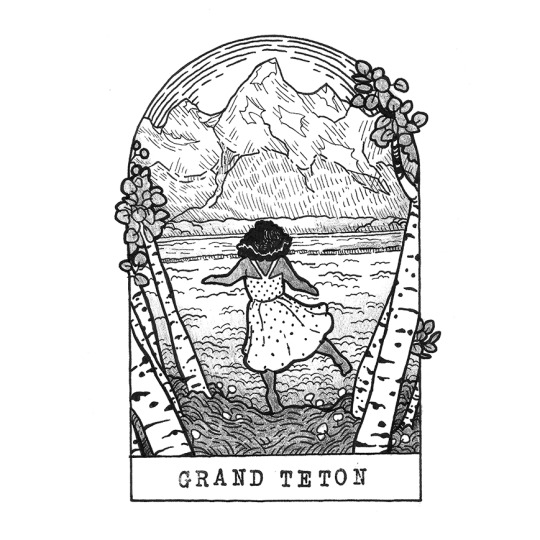
Rangers sometimes talk about their “heart parks”—the intimately special ones that make us go dreamy-eyed and nostalgic. Grand Teton is my heart park. During undergrad, I was going through a rough patch, missing my backcountry work in New Mexico and feeling out of place at Clemson. I told my friend that I “just wanted to go somewhere.” He asked if I wanted to go for a walk. I told him no, I’d like to go to the Grand Tetons. I don’t know why I decided on that particular place in that moment—I’d never been there and had only ever seen photos of the famous mountain group. But my friend said sure, we could go to the Grand Tetons. He proceeded to lead me outside student housing, checked the cardinal directions in the sky, and struck off northwest. I followed him. We walked around campus for hours that night, talking about a hundred different things. It was the first time after returning from New Mexico that I’d felt really heard, really understood, really happy.
A few months later, that friend became my boyfriend, and a few years later, that boyfriend became my husband. There was no question about where we would honeymoon. We went to Grand Teton.
Day 14: "Castle"
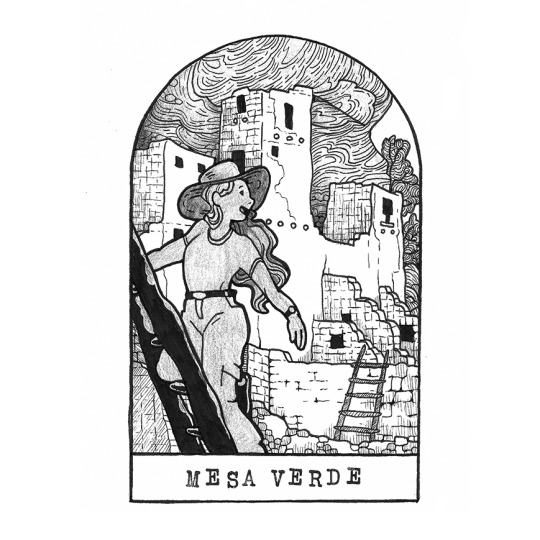
I’ve been struggling with what to say about Mesa Verde, because this site was so incredible to visit that I almost can’t put it to words. I experienced it while conducting my master’s research between stops in Navajo National Monument and Chaco Canyon. Visiting these cultural sites, tied together by sociopolitical events and natural disasters over the span of centuries, drove home how vast the network of humanity was in the Ancestral Puebloan era. These places were huge hubs of activity and massive feats of architecture—not castles, but communities humming with life, love, loss, struggle, wealth, and beauty.
Mesa Verde was also the only place I saw a ranger bring an audience to tears with the emotion in his program. I audited over two hundred interpretive programs that summer, but I remember lowering my clipboard during this particular tour of Cliff Palace, in awe of how powerfully the ranger was able to connect visitors with his own familial ties to the Ancestral Puebloans who had lived there so long ago. The goal of interpretation is to facilitate a meaningful connection between the visitor and the resource, but never have I ever seen anyone do it so profoundly as that ranger in Mesa Verde, 2011.
Day 15: "Dagger"
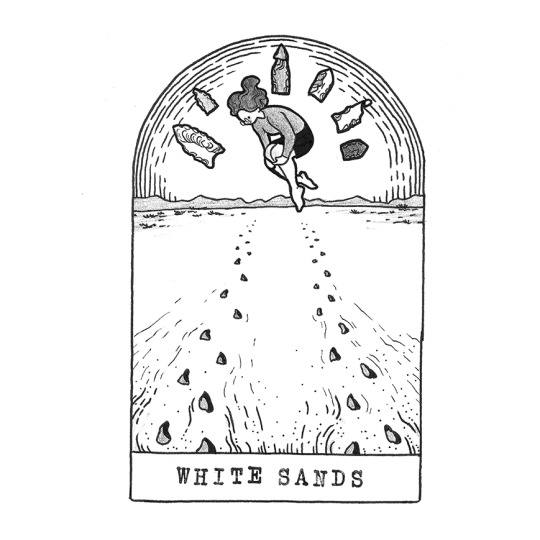
White Sands preserves practically the entire span of human history, from fragments of ancient blades up to the space shuttle and missile launches. But it's the beginning of that timeline that draws me toward this gleaming gypsum dunefield.
I remember where I was when the news dropped—in the Apgar ranger office with a handful of other Glacier rangers. I was working on my hunting and gathering program, where I discussed old facts about projectile points and atlatls, but I stopped when another ranger swore in shock. An email had come through to our NPS accounts with new research out of White Sands. Human footprints preserved in the ancient sediment had been dated--- not to the 13-16 thousand years old we typically associated with the earliest humans in the Americas, but to 23 THOUSAND YEARS OLD. In one short email, our whole office's reckoning of human history almost doubled. Our minds were blown. We celebrated like a bunch of lads after a World Cup win. This world that we walk! Footsteps over footsteps over footsteps! What a privilege.
100 notes
·
View notes
Text
Deep dives into folklore: stone henge

Stonehenge, the iconic prehistoric monument standing on the Salisbury Plain in England, has captivated the human imagination for centuries. This deep dive essay embarks on an exploration of the folklore surrounding Stonehenge and the myriad theories proposed to unravel the enigmatic origins of this ancient structure.
I. Folklore and Mythic Narratives:
Stonehenge's folklore is rich with mythic narratives that span centuries and cultures. In Arthurian legend, Merlin is said to have transported the stones from Ireland and arranged them as a monument of healing. The Welsh tale of the Giant's Dance attributes the creation of Stonehenge to giants who brought the massive stones from Africa. These folklore elements intertwine with the cultural fabric of the British Isles, weaving a tapestry of fantastical tales around the monument.
II. Astronomical Alignments: A Cosmic Connection
One prevailing theory suggests that Stonehenge served as an astronomical observatory, aligning with celestial events such as the solstices and equinoxes. The configuration of the stones appears to have been deliberately positioned to mark the movements of the sun and moon. This theory posits that Stonehenge was a sophisticated calendar or ceremonial site, reflecting the profound importance of celestial cycles in the spiritual and cultural practices of its builders.
III. Rituals and Ceremonial Functions:
Another theory proposes that Stonehenge functioned as a sacred space for rituals and ceremonies. The alignment of the stones with celestial events may have served a dual purpose, allowing the ancient builders to not only mark time but also create a sacred arena for religious observances. The presence of burial mounds in the vicinity suggests that Stonehenge may have been a site for funerary rituals, honoring ancestors and aligning with the cycles of life and death.
IV. Social and Cultural Hub:
Some scholars propose that Stonehenge served as a social and cultural hub, drawing people from distant regions for communal activities and trade. The sheer effort required to transport the massive stones over long distances suggests a collaborative and organized effort. Stonehenge may have functioned as a meeting place where diverse communities gathered for seasonal festivals, trade exchanges, or important cultural events.
V. Symbolic and Metaphysical Interpretations:
Stonehenge's enduring mystery has also fueled more esoteric and metaphysical interpretations. Some believe that the monument possesses mystical energies, acting as a portal or conduit for spiritual experiences. New Age enthusiasts and modern pagans often visit Stonehenge during significant celestial events, seeking a connection with ancient wisdom or a transcendent experience.
VI. Architectural Ingenuity:
The technological prowess of the ancient builders of Stonehenge remains a subject of fascination. The precision with which the massive stones were quarried, transported, and erected suggests advanced engineering skills. Recent archaeological discoveries, such as the Stonehenge Riverside Project, have shed light on the complexity of the surrounding landscape, indicating a network of features that complemented the monument's function.
Stonehenge, with its colossal stones standing in silent testimony to the mysteries of the past, continues to inspire wonder, speculation, and exploration. The folklore surrounding this ancient monument, intertwined with Arthurian legends and tales of giants, adds a layer of enchantment to its narrative. Meanwhile, the diverse theories about its origins—from astronomical observatory to cultural hub—reflect the enduring quest to unravel the multifaceted significance of Stonehenge in the lives of its builders and in the broader context of human history. As ongoing research and discoveries unfold, Stonehenge remains an archaeological and cultural treasure, inviting us to contemplate the enduring enigma of this iconic site.
#writeblr#writers of tumblr#writing#bookish#booklr#fantasy books#creative writing#book blog#ya fantasy books#ya books#deep dives into folklore#deep dives#folklore#writers block#national novel writing month#writers#teen writer#tumblr writers#writblr#writer problems#writerblr#writers community#writers corner#writers on tumblr#writerscommunity#writerslife#writing blog#writing community#writers and poets
21 notes
·
View notes
Text







Lamezia Terme, Calabria, Italy
Lamezia Terme is located on the eastern border of the coastal plain commonly called Piana di Sant'Eufemia, which was created by drying a wide marshy area. It is the third largest city in Calabria by number of inhabitants and has a relatively recent history.
Established in 1968 from the fusion of three pre-existing towns: Nicastro, Sambiase, and Sant'Eufemia Lamezia, it is not only an important regional and national hub due to its strategic location in the centre of the region, but also a crucial business hub for the region's economy. These three towns have contributed to the city's diverse cultural heritage and historical significance.
Lamezia Terme is most famous for its international airport which is situated a few kilometres outside the town.
The Baths of Charon

Despite its modern origins, the name is much older: it derives from the first political community attested on this territory, the Lametìnoi, dating back to protohistoric times.
The Baths, on the other hand, refers to one of the main resources of the area, the Terme di Caronte, known since Roman times as Aque Angae. These four springs are located on the slopes of the Reventino mountain massif and, combined with the current of the Bagni river, give rise to different degrees of temperature: the highest reaches 39°C, hence the name Charon.

The secrets of ancient Terina
The first human settlements in what is now modern Lamezia Terme were discovered in 1865, when jewellery was found in the area of Sant'Eufemia Vetere, which was later sold to the British Museum in London, which still preserves it today.
This discovery, known as the Treasure of St Euphemia, was the first in a long series, which during the 20th century confirmed the ancient settlement of Terina. It was not until 1997, however, that it was decided to initiate a systematic search that identified a well-structured urban layout, of which we now know a living quarter built with parallel axes that define a regular urban grid. According to the most widely accepted hypothesis, this would be the extension of a pre-existing structure dating back to the 5th century BC.
Two rooms of the Lametino Archaeological Museum are dedicated to ancient Terina. Lametino Archaeological Museum housed in the Monumental Complex of San Domenico. Divided into three sections: Prehistoric, Classical and Medieval, will give you an insight into the history of this area, from the earliest times. There is, for instance, a hydria, which is a vase, dated between 380 and 370 BC, as well as everyday objects.

The ruins of the medieval castle
There is still much to discover in Lamezia Terme, especially in the historic city centre. On Hill of San Teodoro, stands the Norman castle of Nicastro about whose origins there is some dispute. Built on the hillside, a unique strategic position to control the surrounding plain all the way to the sea, according to some dates back to Byzantine era, according to others Svevo-Normana.
All that remains of the original structure are four towers, the ramparts, walls and a buttress with a small loggia; the earthquake of 1638 caused great damage to the structure, but at the same time contributed to the legends that populate it.
Photos by Pino Elia
Follow us on Instagram, @calabria_mediterranea
#lamezia terme#calabria#italy#italia#south italy#southern italy#mediterranean#italian#mediterranean sea#seascape#sea#europe#landscape#italian landscape#buildings#cityscape#city#town#architecture#building#people#flowers#lamezia#lameziaterme#history#greek#magna graecia#magna grecia#baths#greek art
34 notes
·
View notes
Text
How do you keep from Copy/Pasting existing Cultures into your Worlds?
Basically just as the title says, and I'm sure there's been pleeeeenty of discussion on the topic, but I'm genuinely curious what makes your cultures unique and original (especially when the modern aura of writing is "everything's been done"). Furthermore, is having a copy/paste culture a bad thing? For context, I'm primarily a Game Master (GM) who also on occasion writes as well as works in the TTRPG actualplay space. When you have an audience (whether friends or fans) is it necessarily a bad thing to have familiar locations, themes, and even characters that mimic real life? Can it be easier for an audience to just assume we're in "Ancient Rome" or "Habsburg controlled Austria"?
For me I do like creating totally original locations with their own weird political systems influenced by magic, gods, monsters, and anything else fantastical--BUT sometimes I find a setting is more interesting of just "what if Romans could directly interact with their deities?". For me I just find the idea of almost "alternate history" but in my uniquely fantastical setting interesting. However, I also understand that some people like genuinely different worlds with no trace of the real world left behind.
When creating unique cultures I try to combine elements to create something more unique. For example I'm currently working on the ancient periods of my current homebrew world, and specifically in a portion I haven't particularly worked on before. In Evrosea, a sort of "ancients world" where Greco-Roman culture lives on well into the medieval 15th Century (of course technology has changed and evolved) I find myself studying more ancient histories. I knew from before I fully began working on worldbuilding Erosea that there was some sort of "Roman Empire" which spread its tongue as a sort of lingua franca across the continent of Dulgren (aka why Common exists in my D&D world). Also originating from the region of Evrosea was the sorta monolithic pantheon of "new gods" (aka Catholicism). So I have the ideas of imperialism and religious importance in this region. So the very clear start was Rome itself, but how could I make this Rome unique? Well here's what I found from my research on Ancient Rome:
Many pre-settlers, and even contemporaries of Ancient Rome, in Italy were nomadic grazers and herders.
The Aeneid, which tells one of the many origin stories of Ancient Rome, ties in the ancient Greek tale of the Trojan War, and makes Rome the successors of Troy.
That many of their religious practices were tied up with the Senate (especially after the abolishment of the crown).
Finally, while perhaps never directly ruled by the Etruscans, their neighbors were much more confederate like and were similar in culture rather than being a unified people or kingdom.
Taking the information I found I twisted and jumbled much of this random history and constructed a group of nomads who controlled the fertile valleys of Uvemos (home region of the ancient Carinaens, my replacement for the Romans).
Many of these nomads worshipped similar sounding gods (if not outright the same gods), and most of them lived off the lands of Uvemos. Only a select few of whom ever settled into cities. However, long after the first nomads of Uvemos walked the hilly countryside arrived a band of pirates and raiders, terrors of the ancient world, many knew not their names, but they quickly accrued a nickname, "The Sea People" (see Sea Peoples on Wikipedia for more, TL;DR a bunch of random marauders who attacked or even helped cause the collapse of some Bronze Age Civilizations). One such pirate was said to be the Prince Laogonus, an exile from Apeiros, who was said to be a direct descendant of the God King Ulios himself. Laogonus settled down on the banks of Janian Sea in a small dirt settlement near to the roaming tribes of Uvemos. Many years later the small city of Carina was established as a blossoming trade hub by the many different tribes of Uvemians. Of these tribes was born a Chieftain's daughter, Aurora. Aurora was said to be descended from the god blood of Ulios, and when she prayed to her great grandsire on the eve of battle she was enveloped in holy light-- thus becoming the world's first cleric. Of her legacy were many rituals formed and practices established, and the civitas mille clericorum* was born.
*(civitas mille clericorum) meaning "city of a thousand clerics," named after the heavy religious undertones established by the first cleric Aurora, at least according to legend.
Super cool right?? I combined some other ideas than the ones I established such as the Sea People from the Collapse of the Bronze Age, as well as these kind of Shinto-like-beliefs in the Carinaen religion, which, to me at least, seems the most like what Ancient Roman beliefs would look like to us today (though I didn't really get to talk about in my blurb). I like taking existing pillars of cultures and extending them, now rather than just being a complete Roman rip-off there's more of this nomadic or tribal culture, at least to early Carinaen history, there's more of a nautical legacy (unlike Rome, who didn't establish a truly working navy up until the Punic Wars), and finally the city of Carina is a beacon for holy warriors and classes like Paladins and Clerics (again this is D&D so that's oriented towards that).
But tell me what you think, and how best do you come up with your fictional cultures/countries? Do you merely copy off of pre-existing cultures or do you fully work from the ground up? I'm super curious to hear what you all have to say!
I'm also tagging a couple friends since I'm curious of your responses @hessdalen-globe, @northernthiefcranberry, @kerghoulen, and the ever wonderful @somethingclevermahogony.
Also guys I need you to pull me out, I'm this close to dropping out of the arts and trying to get into Harvard to do Ancient Studies. Send Help.
#writer things#worldbuilding#writers on tumblr#fantasy#dungeons and dragons#d&d#d&d teaser for my campaign#writing#original story#fantasy worldbuilding#fantasy fiction#developing countries#I don't think that's what they meant but technically true#roman myths#roman mythology#inspired#creative writing#ancient history#ancient rome#antiquity#fantasy world#campaign#dnd campaign#advice#discussion#let’s discuss#discusses
21 notes
·
View notes
Note
I don't know if this has been asked, but is there a specific culture, country, and/or time in history that inspired "Honor Amongst Thieves"?
It was touched on a bit in this ask here, but its been awhile so it's probably time for a refresher!
I would say my love of history as a whole inspired the world building of Honor Amongst Thieves, and specifically the Mali Empire, the Songhai Empire, Egypt, and Ancient Greece. I would also say the historical clashes between nomadic people and the settlement of tribes is another key focus.
One of the things I love about history is the interconnectedness of people. Water moves trade, trade moves people, ideas, and customs. Soon we're all intertwined for better or for worst. HAT is influenced by the human beings become a family, a tribe, and sometimes even an empire. (Also the wild story of Johnathan Wild. He's where the thieves thing comes in.)
We all know that the fantasy genre has been caught in a western European stranglehold for centuries now. I love those stories, but I really wished for something different. People of color often experience being robbed of past and present. We're oddly absent in historical literature, fantasy or otherwise, and we also aren't in sci fi much. These are genres I love and the ommition of other people and cultures always felt so odd to me!
Timbuktu used to be a hub for scholars from the world over. One of the early Ottoman Emperors had beef with Vlad the Impaler. Ancient China was in contact with kingdoms in Africa. Although our tellings of history are pretty isolated, we've always had our arms outstretched to each other. I wanted to write a multicultural, magical world, packed with drama, romance, court intrigue, and all the other stuff I like.
So to get back on track to your question, Honor Amongst Thieves is inspired by multiple cultures and time periods.
You might see Silla era and Joseon era influences in Nari, while also seeing Tuareg and Egyptian influences in Sutek. Timbuktu scholars might be really similar to the mages cloistered away somewhere on the outskirts of Hashind. I know I went on a whole paragraph about history, but Honor Amongst Thieves isn't an attempt to rewrite history. It's a world like ours, with people like us, with only a smidge more magic, and jacked up rivers because I'm not a geologist/cartographer.
#worldbuilding#interactive fiction#if wip#game development#interactive novel#writing#writing inspiration#fantasy#high fantasy#HAT Lore#honor amongst thieves#world history#culture#hat if
63 notes
·
View notes
Text

Evangeline Kingdom has 16 major territories (also called cities or holds). This article contains some information about each of them.
Realistically, I imagine there are a lot of little small towns and villages between these cities, but they are just too insignificant to map.
EVANGELITE TERRITORIES
Glasstide - Located at the northwestern tip of Noalen in the Frozenwind Pass region. Glasstide is one of the coldest cities on Looming Gaia, and also Evangeline Kingdom’s least populated territory. Its main industries are fishing and whaling. It’s an open secret that this city has the highest concentration of lycanthropes on Looming Gaia. This is because of its remote location, the fact that lycanthropes are hardy to cold weather, and the mass migration of lycanthropes to this location during the Full Moon Genocides. Living in such a cold, harsh region is difficult for most peoples, but those with lycanthropy seem to thrive here.
Wintermoore - Located in the mountains of the Frozenwind Pass region. This city was supposedly the birthplace of the first Stoneshaker minotaur clans. For much of its history it was populated by minotaurs, centaurs, and elves, but this changed in the 4th Age when it was violently conquered by Evangeline Kingdom. Its original population was enslaved and replaced with Evangelite commoners. It is now a mining town that provides much of the kingdom’s iron.
Weypine - Located in the cold, forested Winterwood region. It’s believed that this was the birthplace of the Namarie elves, and for most of history it was populated by their clans. It was later conquered by Evangeline Kingdom in the 4th age, its original population was enslaved, and now it is an Evangelite city best known for its logging industry.
Eastwalk - Located on the northern edge of the Timberland Forest region. Eastwalk is a prosperous industrial hub that exports many types of raw resources to the rest of the kingdom, most notably lumber, seafood, and mushrooms. It is one of the few Evangelite territories that has an electrical grid, which is powered by primitive wind turbines along the coast. However, most of the electricity generated is used to power its industrial operations, meaning the average Eastwalk citizen is still living in the dark ages of wood and coal.
Queenswater - Located along the Crown River in the Timberland Forest region. Queenswater is populated by many of Evangeline Kingdom’s wealthiest citizens. With its temperate weather, scenic location, and dam-powered electrical grid, it boasts the highest land values in the kingdom, so its no surprise that its biggest industry is real estate.
Waterview - Located around Crown Lake in the Timberland Forest region. Satyrs and nymphs used to hold large, rowdy revels here until the 4th Age, when Evangeline Kingdom enslaved all the region’s satyrs. Today its famous revels have been replaced by stuffy Evangelite galas, which are attended by the kingdom’s upper classes. Waterview is now a resort town mainly populated by tourists and the wealthy.
Newell - Located in the Timberland Forest region. This city is integral to Evangeline Kingdom’s fur and leather industry, with its extensive fur trapping, tanning, and textile processing operations. Local faunae advise business owners about animal populations in the forest, controlling what, when, and where they hunt from season to season. Such practices keep these industries sustainable under the Nymph Pact. However, some business owners feel the nymphs are harming their profits, and hire mercenaries to poach prohibited animals anyway. When caught, these poachers are dealt with swiftly and mercilessly by the faunae.
Aldfog - Located in the south Timberland Forest region. In ancient times, Aldfog was exclusively populated by satyrs and nymphs, who spent their days frolicking freely in the forest. Today, the satyrs’ descendents are enslaved to the Evangelites and forced to work for the city’s booming lumber industry. Local nymphs now oversee operations and replant trees that the Evangelites chop down. Its deep forested location has made Aldfog attractive to vampires, most of which are Evangelite slaves who got kidnapped into existing clans. These vampires often dabble in dark magics like necromancy, creating ghosts and zombies that escape into the woods. Many citizens and slaves seem to mysteriously disappear into the forest every year, never to be seen again. All of these things contribute to Aldfog’s “creepy” and “strange” reputation.
Rockreach - Located near Ironmaid Mountain. Rockreach was the birthplace of the first golden dworf clans, who quickly discovered and utilized its rich ore deposits. Their advanced metallurgy operations began polluting the river that provided water for many of the region’s other peoples, and this led to a long series of wars. Some time around the 4th Age, Rockreach couldn’t defend itself from its many enemies anymore, so it assimilated with Evangeline Kingdom for protection. Under Evangelite reign, it was forced to relocate its dirty industrial operations to Zareen Empire to satisfy the Nymph Pact. Today the river is clean, but Rockreach’s ore deposits are depleted, its impressive processing factories are abandoned, and most of its original dworfen populace has immigrated away to Zareen Empire. Now its economy is supported by a great quarry, which provides most of the kingdom’s stone. This stone-harvesting operation is overseen by local oreads. This was once the most technologically-advanced city in Evangeline Kingdom, but now it is but a giant pit where slaves toil away with primitive tools.
Silverspring - Located in western Blue Valley, Noalen. Ranching is this city’s bread and butter, as its vast, fertile grasslands are prime grazing grounds for livestock. Cattle, sheep, turkeys, and horses are the most common animals ranched here. Silverspring is Evangeline Kingdom’s largest meat producer. Many livestock-themed festivals and contests are held here every year, attracting visitors from all over the kingdom.
Evangeline Capital - Located around Bluerock Lake. The capital is the largest city in Evangeline Kingdom. It is a grand and heavily-fortified metropolis that acts as the kingdom’s main commercial, culture, and entertainment hub. Producers from all over the kingdom come here to sell their goods, especially during festivals, which attract many tourists. It is also home of the largest Lindist temple in the kingdom.
Merrowville - Located in the eastern Blue Valley region. Merrowville has had a troubled history since the rise of Folkvar Kingdom, as it has been captured, lost, and recaptured more than any other Evangelite territory. Its exposed location makes it rather hard to defend, so this isn’t likely to change until the war ends. Currently it’s home to a large Evangelite military presence, and all these soldiers gives it an infamous reputation for crime.
Greenhearst - Located in the Blue Valley region. The majority of the kingdom’s crops are grown in Greenhearst, but this city exports a lot of food to foreign kingdoms as well. Life here is quiet and simple, with slaves vastly outnumbering citizens. There isn’t much to do except work the fields and drink, and alcohol stays cheap thanks to the city’s local distilleries. In addition to food, Greenhearst provides Evangeline Kingdom with much of its beer too. Greenhearstians are stereotyped by other Evangelites as inbred, uneducated, drunks, but Greenhearstians themselves take pride in their rural, outdoorsy culture.
Rivermere - Located north of the Bluerock River. Rivermere sits right on Evangeline Kingdom’s southern border. It is primarily a military city, home to the largest barracks and training academies in the kingdom. Rivermere spares no expense on defenses to keep itself safe from foreign powers, but despite its efforts, its citizens are plagued by the rampant crime within its own walls. It is shamefully known as a hub for drug and sex trafficking.
Kelvingyard Town - Located between the Bluerock River and Refuge River. Kelvingyard Town is Evangeline Kingdom’s most infamous city, as its home to a massive slaving operation called Kelvingyard. The city’s entire economy was built around this slaveyard, which is also the source of all its electricity. Slaves are forced to turn heavy wheels which produce electricity for the city’s upper classes. The town itself is described as a drab, depressing place. Most of its citizens are employed by the Kelvingyard Slaving Company. The city’s strategic location allows slavers to snatch refugees attempting to travel from Yerim-Mor to Folkvar, providing a constant stream of new stock for its champion industry.
Oaken - Located on Oaken Island. Evangeline Kingdom has three domestic siege dragons in its possession, which they threaten to release upon their enemies as weapons of mass destruction. These dangerous beasts are contained in a facility here on Oaken Island, and the town’s whole existence centers around training and caring for them. This isolated location ensures minimal damage to the rest of the kingdom should the dragons escape, though the possibility is still taken very seriously, as the loss of the dragons alone would devastate the kingdom’s economy and military might. All of the kingdom’s aspiring dragoneers must spend at least one year caring for the siege dragons at Oaken before they can graduate. The city is home to many soldiers as a result, but also farmers, ranchers, fishermen, and hunters that feed them. Not to mention all the auxiliary business to support those industries, such as tool makers, shopkeepers, and even sex workers. The siege dragon containment facility is the keystone holding all of these livelihoods together, and should it collapse, all of Oaken collapses with it.
*
Questions/Comments?
Lore Masterpost
Read the Series
12 notes
·
View notes
Text
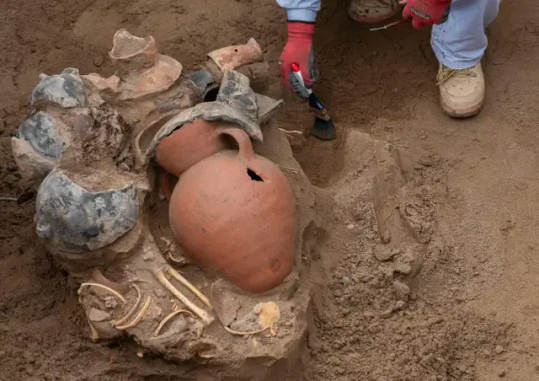
Eight Mummies and Pre-Inca Artifacts Discovered in Peru
Peruvian gas workers made an astonishing discovery beneath the ancient streets of Lima this week — uncovering eight mummies and a number of Pre-Inca artifacts.
“We are recovering those leaves of the lost history of Lima that is just hidden under the tracks and streets,” said Jesus Bahamonde, an archaeologist with Calidda, the company that distributes natural gas to the 10 million residents of Peru’s capital city.

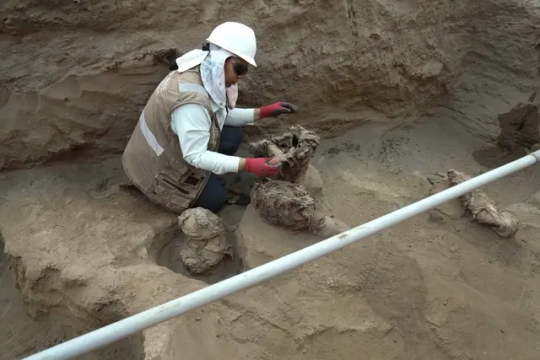
Since the company began expanding its gas line system nearly two decades ago, they’ve racked up more than 1,900 archeological finds — including mummies, pottery, and textiles, Bahamonde said.
In the most recent discovery, the eight mummified males were found bundled up in the trench, wrapped in cotton cloth and tied with ropes braided from vines. Workers found the bodies about a foot below the ground.
Archeologists with the gas company believe the men belonged to a pre-Inca culture called Ichma, which formed around A.D. 1100 and flourished in the valleys around Lima until it was absorbed into the Inca Empire in the late 15th century.
Roberto Quispe, an archeologist who worked in the trench, sad the mummified bodies are likely two adults and six minors.
Lima, now an urban economic hub, has been occupied by humans for more than 10,000 years, from the Pre-Incan cultures to the Spanish conquistadors who claimed the land in the 16th century.

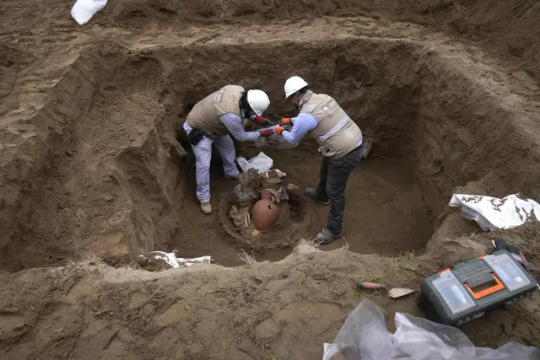

Many archeological finds have proven to be from more recent times.
In 2018, Quispe and other archaeologists working in the La Flor neighborhood found wooden coffins holding three Chinese immigrants buried in the 19th century.
The bodies were found alongside opium pipes, hand-rolled cigarettes, shoes, Chinese playing cards, a Peruvian silver coin minted in 1898 and a certificate of completion of employment contract, written and Spanish and dated 1875.
The eight mummies were found amidst braised chicken restaurants and a road that leads to Peru’s only nuclear power station.
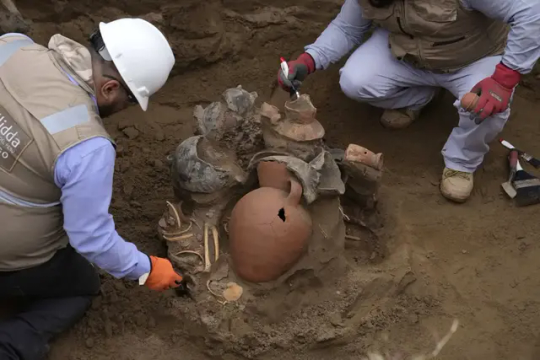
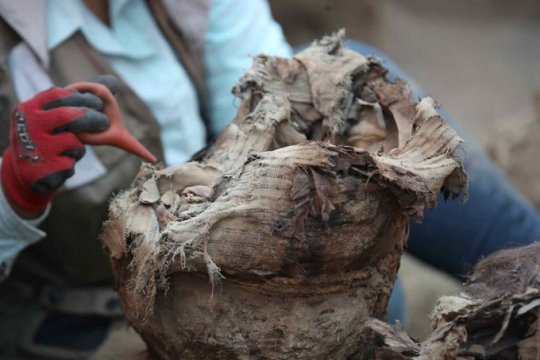

“When the Spaniards arrived in the 16th century they found an entire population living in the three valleys that today occupy Lima … what we have is a kind of historical continuation,” Bahamonde said.
Most of the archaeological sites uncovered by Calidda have been burial sites discovered on flat ground, Bahamonde said.
Aso scattered throughout the urbanized city are more than 400 larger archeological sites, known in the indigenous Quechua language as “huacas,” which are sacred adobe constructions typically found on hilltops.
By Patrick Reilly.

#Eight Mummies and Pre-Inca Artifacts Discovered in Peru#Lima Peru#ancient grave#ancient tomb#ancient artifacts#archeology#archeolgst#history#history news#ancient history#ancient culture#ancient civilizations#Inca history#Ichma history
56 notes
·
View notes